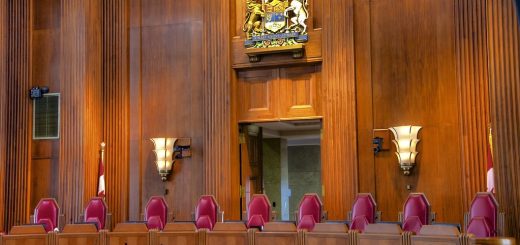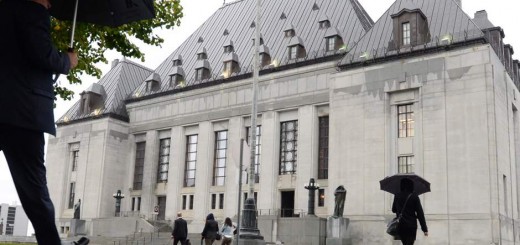Informer Privilege Hearings: Unfairly Non-Adversarial or Appropriately Restrictive?
Leave to appeal has been granted by the Supreme Court of Canada (“SCC”) in R v Bobby Singh Virk et al. This appeal will answer the question of whether counsel for the accused may be present at an in camera hearing to determine the application of informer privilege. More specifically, the SCC will consider whether a court has breached its duty to protect informer privilege if it permits defence counsel to learn the identity of an informant, information that might identify an informant, or undertakings not to disclose this information.
To arrive at a finding on these issues, the court will consider whether the first stage of the procedure in Named Person v Vancouver Sun, [2007] 2 SCR 253 [Named Person], applies in this case, so that the accused and their counsel are not entitled to attend a hearing to determine a claim of informer privilege where the evidence may or will identify the informer. Finally, the court will determine whether section 37 of the Canada Evidence Act, RSC 1985, c C-5 [CEA], vests it with the discretion to override the substantive rule of law barring disclosure of an informant’s identity.
Background
The British Columbia Court of Appeal (“BCCA”) previously considered whether the trial judge erred in ordering that defence counsel may be present at an in camera hearing to determine whether informer privilege existed. R v Virk, Basi and Basi, 2008 BCCA 297 [Virk], was not a unanimous decision, and both the majority and the dissent raised compelling arguments regarding the application of precedent and statutory interpretation. Though the two sides disagree in several respects, one issue stands out as the true divisor. The SCC’s decision will likely hinge on the interpretation of the civil Named Person case, and whether its in camera procedure applies in a criminal context. If the court decides that this precedent does apply, then defence counsel will likely not be permitted into the in camera hearing.
The three accused were on trial for corruption, fraud and breach of trust resulting from alleged misconduct while civil servants. During pretrial proceedings, their defence counsel submitted a lengthy application for disclosure of documents, and they were provided with several redacted documents. They applied to “unredact the information” in those documents, but the Crown asserted informer privilege over them. The Crown then applied to establish informer privilege, and asked to call its evidence supporting the existence of the privilege in an in camera hearing. This would exclude the accused, their counsel, and the public from the courtroom.
To do this, the Crown’s Special Prosecutor filed a certificate under s. 37(1) of the CEA certifying their objection to the defence’s disclosure request, and arguing that the presence of defence counsel in an in camera hearing would violate that privilege and identify the informant. After the court heard submissions on the issue, the trial judge dismissed the Crown’s application, and defence counsel was permitted to be present during the in camera hearing. However, she ordered that defence counsel were not to disclose anything heard in the hearing, not even to their clients, or else they would be held in contempt of court.
The Crown appealed this decision to the BCCA. It was not in dispute whether the hearing to determine if informer privilege applied should have been held in camera. Rather, the issue raised was whether the judge erred in ruling that defence counsel could be present at the in camera hearing, held to determine whether the informant privilege was to apply. Further, the appellate court was asked to consider whether that ruling could be appealed under s. 37 of the CEA. The Crown argued that defence counsel’s presence at the in camera hearing would inevitably breach informer privilege, and that the judge had failed in her duty to protect this privilege. The defence countered, by submitting that, rather than having this inevitable effect, the impugned order was merely procedural in nature. As well, the defence believed that the Court of Appeal did not have jurisdiction under s. 37 to hear an appeal.
The Majority
In Chief Justice Finch’s written reasons, with which Mr. Justice Donald concurred, he first addressed the Crown’s heavy reliance upon Named Person to support the position that counsel for the appellants should be excluded from the in camera informant hearing. In Named Person, the appellant was being sought for extradition. At trial, he applied for an order that the proceedings continue in camera, a request to which the Attorney General consented. An amicus curiae (friend of the court) was appointed during the in camera proceedings, and was provided with exhibits and documents. Counsel for the local media applied to review these documents and the extradition judge allowed that application.
Precedent
The trial judge did not agree that Named Person supported the position that counsel for the appellants should be excluded from the in camera hearing, as that case contemplated whether or not the media should be present. The question of whether an accused or defence counsel should be present was not addressed because the context of this case was civil, not criminal like Virk. As well, as Justice Finch pointed out, it did not involve s. 37 of the CEA. He found that the trial judge was correct in finding Named Person to be irrelevant in the context of Virk.
On the basis of other, more relevant authorities, Justice Finch concluded that it was within the trial judge’s discretion to adopt the procedure she did in considering whether informer privilege existed. He looked to precedents that did consider s. 37, and found that s. 37 applications tended to afford the judge considerable latitude. A judge’s broad discretion on s. 37 applications was also indicated by the language of the section. For example, s. 37(6.1) allows the court to receive anything into evidence that is reliable and appropriate, even if it would otherwise not be admissible; as well, s. 37.3(1) allows a judge presiding at a criminal trial to make any order necessary to protect the right of an accused to a fair trial.
The Possibility of Appeal
Turning to the second issue on appeal, namely whether or not there can even be an appeal from a ruling under the s. 37 provisions, Justice Finch first considered the meaning of the trial judge’s order. The Crown said that the order would inevitably result in the release of the informer’s identity, as any of his substantive evidence will lead to disclosure of information that may tend to identify him and breach the protective privilege. The Crown pointed to passages in the judge’s reasons as evidence that the order authorizes disclosure of confidential information; they argued that if the trial judge did not intend to allow defence counsel to hear information that might identify the confidential informant, she would not have required undertakings of non-disclosure from defence counsel.
Justice Finch argued that the purpose of the in camera hearing is to determine whether there is a confidential informer, and if so, whether he or she is protected by informer privilege. The trial judge said that she required further information (for instance, whether the witness even came to the police in confidence), because it was not readily apparent to her at that stage whether the privilege applied. Justice Finch, in light of the unanswered questions, doubted whether the order was one for disclosure.
Rather, he sided with defence counsel’s view that the order was procedural. Their argument was that the purpose of the in camera hearing was to determine whether there was any basis on which informer privilege can be asserted. Defence counsel should be present at such a proceeding because they are entitled to test whether, within that evidence, there is any foundation to the claim for informer privilege. They could inquire into the circumstances under which the privilege claim arose, and could assess the credibility of the witness called to justify the assertion of privilege. Justice Finch agreed with this interpretation, and stated that at the hearing stage, the judge did not have enough information to allow her to make an order authorizing, or prohibiting, disclosure.
Justice Finch went on to say that even if his interpretation was incorrect and it was, in fact, an order for disclosure of confidential information, it was still within the discretion granted by s. 37. As he stated earlier, that section permits the judge much discretion; he believed that it was clear from the trial judge’s reasoning that she was aware of the importance of informer privilege and the accused’s right to a fair trial. As well, s. 37.3 authorizes the judge to make any order necessary to protect the accused’s right to a fair trial. Therefore, even if the order was one for disclosure, it was made within the judge’s discretion.
Finally, Justice Finch found that the trial judge did not make any order under s. 37(4.1), (5) or (6), the only subsections from which an appeal may be taken. This means that there was no right of appeal in respect of the trial judge’s order. He ultimately dismissed the appeal on the ground that the appellate court had no jurisdiction to entertain it, though as his reasons demonstrate, several other factors were behind his decision.
The Dissent
Madame Justice Ryan, on the other hand, disagreed with Justices Finch and Donald. She believed that the trial judge’s order actually did authorize disclosure under s. 37(4.1) of the CEA, and that the Crown’s appeal was properly brought to the Court of Appeal under s. 37.1(1). As well, she held that the trial judge erred by permitting defence counsel to be present during the privilege hearing.
Firstly, Justice Ryan concluded differently on the matter of the order’s effect. In her view, the trial judge actually did order disclosure to the defence on the condition that they provide undertakings not to reveal anything disclosed in the in camera hearing. The trial judge then adjourned the hearing to permit the Crown the opportunity to appeal her ruling. According to Justice Ryan, the trial judge’s own reasons support the conclusion that she ordered disclosure.
Her second, more involved argument dealt with the application of Named Person. She began by noting that informer privilege is a powerful protection that is only excepted when innocence is at stake. She alluded to Justice Sopinka’s ruling in R v Stinchcombe, [1991] 3 SCR 326, to demonstrate that the Crown’s disclosure obligations are highly important. But even in this seminal criminal procedure case, Sopinka J. recognized that full disclosure is limited when informer privilege is raised. Though information should be disclosed if it would impair the right of the accused to make full answer and defence, he noted that non-disclosure is justified by the law of privilege.
After discussing Sopinka J.’s high regard for informer privilege, even in a criminal context, Justice Ryan characterized the question on this appeal as whether defence counsel should be present in an informer privilege hearing. She did not distinguish between civil and criminal procedures, like the majority. By characterizing the case in this way, Justice Ryan disagreed with Justices Finch and Donald that Named Person was not relevant to Virk.
On this issue, the defendants’ counsel, like the trial judge, argued that the procedure laid out in Named Person did not apply to Virk because the media were not parties and, unlike criminally accused persons, did not have the right to make full answer and defence. For this reason, the media did not have the right to attend the hearing, and this factual difference justified the majority view that Named Person was irrelevant to the issues presented by a criminal trial. Justice Ryan disagreed, and noted that there is only one exception to informer privilege: when innocence is at stake. There is no similar exception for the right to make full answer and defence, and for this reason, she would argue that Named Person did apply to the facts of Virk.
Justice Bastarache, in Named Person, described the procedure to be followed when the question of informer privilege arises. He noted that in criminal or quasi-criminal proceedings, if an individual discloses confidential informer status to the court, the proceedings should be adjourned and then continue in camera in order to determine if sufficient evidence exists to justify this status. When the judge is determining whether the privilege applies, third parties should not be admitted into the in camera proceedings.
The only parties present, according to Bastarache J., should be the person who seeks the protection of the privilege and the Attorney General. This is because the only determination to be made at this point is whether the person is a confidential informer. There is no balancing of legal interests, and only these two parties can contribute to the determination. Bastarache J. points out that other parties aren’t only necessary, but they may actually be harmful; as the number of people at the hearing grows, so too does the risk of disclosure.
The trial judge’s concern that the defence counsel’s absence would prevent full argument influenced her decision to allow them access to the confidential informant hearing. However, Justice Ryan again looked to Bastarache J.’s reasoning in Named Person to undermine the trial judge’s decision; he suggested that the troubling, non-adversarial nature of such a hearing is alleviated with the appointment of an amicus curiae. This would have been a preferable option to that exercised by the trial judge in Virk. Since Justice Ryan held that Named Person should apply to Virk, Bastarache J.’s procedure would then apply. He specified that third parties (other than curii) should not be present during hearings to establish informers; as such, the trial judge erred by allowing the defence counsel to participate in the hearing.
Following this finding, Justice Ryan addressed the related question of whether the trial judge’s broad discretion permits the inclusion of defence counsel at this type of in camera hearing. But after conducting additional case analysis, she found that judicial discretion does not extend that far.
While s. 37 of the CEA gives a trial judge the freedom to determine which type of hearing will be conducted and who may attend it when certain public interests are at issue, the centrepiece of informer privilege is the protection of the informer’s identity. Nothing in s. 37 can dilute that requirement, and the trial judge’s discretion is limited by the parameters prescribed by informer privilege. Contrary to Justices Finch and Donald, Justice Ryan agreed with the Crown that the trial judge erred in permitting defence counsel to be present during the hearing on informer privilege. She would have set aside the order of the trial judge.
Conclusion
After examining both the majority and dissenting decisions, it is clear that their main point of departure was whether Named Person applied to a criminal case. I think that Justice Ryan’s argument was more persuasive on this issue, given that the right to make a full answer and defence is not an exception to informant privilege, and that Justice Bastararche’s in camera hearing procedure can apply in criminal contexts. Since the interpretation and application of Named Person is one of the issues facing the SCC, it seems highly possible that this decision may be overturned.








Join the conversation